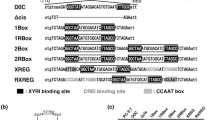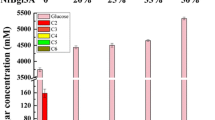Abstract.
The xylanase II (xyn2)- and endoglucanase I (egI)-encoding regions of Trichoderma reesei QM6a were successfully expressed in Aspergillus niger D15 under the transcriptional control of the glyceraldehyde-6-phosphate dehydrogenase (gpd) promoter from A. niger and the glaA terminator of Aspergillus awamori. A stable xyn2 transformant produced β-xylanase activity of 8,000 nkat/ml and 5,000 nkat/ml in shake-flask cultures containing defined or 20% (v/v) molasses medium, respectively. The recombinant Xyn2 enzyme expressed highest activity at pH 5–6 and 50–60 °C and retained more than 75% of its activity after 3 h of incubation at 50 °C. A stable egI transformant produced endo-β-1,4-glucanase activity of 2,300 nkat/ml in shake-flask cultures containing defined media and about half the activity in 20% molasses medium. Maximum endoglucanase activity was obtained at pH 5 and 60 °C. Both Xyn2 and EgI retained >80% activity after incubation at 50 °C for 3 h. The heterologous Xyn2 and EgI represent a significant portion of the total extracellular proteins produced.
Similar content being viewed by others
Author information
Authors and Affiliations
Additional information
Electronic Publication
Rights and permissions
About this article
Cite this article
Rose, .S., van Zyl, .W. Constitutive expression of the Trichoderma reesei β-1,4-xylanase gene (xyn2) and the β-1,4-endoglucanase gene (egI) in Aspergillus niger in molasses and defined glucose media. Appl Microbiol Biotechnol 58, 461–468 (2002). https://doi.org/10.1007/s00253-001-0922-3
Received:
Revised:
Accepted:
Issue Date:
DOI: https://doi.org/10.1007/s00253-001-0922-3




